NMR from an Instrument point of view
Contents
This section focuses on the NMR instrument.
All instruments have three basic components: a signal generator, a sample holder and a detector.
For NMR:
- signal generator - radio
- sample holder - such as an NMR tube in a spinner.
- detector - antenna
An NMR instrument has a fourth component, a magnet, that is used to put the sample into an excited state. This excited state is then probed with the signal generator and the result detected with the detector. An instrument with a superconducting magnet is shown below. These systems can be very expensive, in the millions of dollars for the best ones. Due to the high technology required there are only a few manufacturers. The instrument pictured is about 8 feet tall.
Signal Generator
The signal generator is a regular radio transmitter design.
Sample Holder
For solution NMR, a normal sample consists of about 0.75ml placed into an NMR tube:
This sample is then put into a spinner that then sits within the magnet which has what is called a probe in it. This probe contains the antennas for the transmitter and receiver.
Detector
The signal coming out of the probe is very weak so it has to go through a powerful preamplifier first, then on to the receiver.



